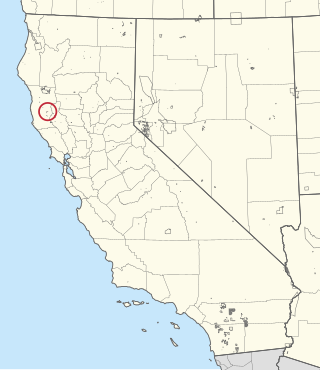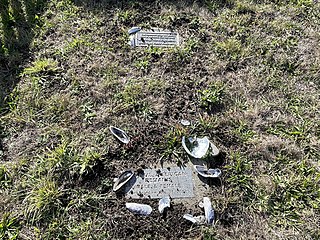
The Pomo are a Native American people of California. Historical Pomo territory in Northern California was large, bordered by the Pacific Coast to the west, extending inland to Clear Lake, and mainly between Cleone and Duncans Point. One small group, the Tceefoka, lived in the vicinity of present-day Stonyford in Colusa County, separated from the core Pomo area by lands inhabited by Yuki and Wintuan speakers.
The Federated Indians of Graton Rancheria, formerly known as the Federated Coast Miwok, is a federally recognized American Indian tribe of Coast Miwok and Southern Pomo Indians. The tribe was officially restored to federal recognition in 2000 by the U.S. government pursuant to the Graton Rancheria Restoration Act.
The Lytton Band of Pomo Indians is a federally recognized tribe of Pomo Native Americans. They were recognized in the late 1980s, as lineal descendants of the two families who lived at the Lytton Rancheria in Healdsburg, California from 1937 to about 1960. The tribe now has around 275 enrolled members. It has a casino in San Pablo, California, and has proposed to build housing for tribe members, plus a winery and a hotel, just west of Windsor, California, in Sonoma County.
Kashaya has several meanings, see:
The Hopland Band of Pomo Indians of the Hopland Rancheria is a federally recognized tribe of Pomo people in Mendocino County, California, south of Ukiah. The Hopland Band Pomos traditionally lived in the Sanel Valley.
Gregory Michael Sarris is the Chairman of the Federated Indians of Graton Rancheria and the current Chair of the Board of Trustees of the Smithsonian's National Museum of the American Indian. Until 2022, Sarris was the Graton Rancheria Endowed Chair in Creative Writing and Native American Studies at Sonoma State University, where he taught classes in Native American Literature, American Literature, and Creative Writing. He is also President of the Graton Economic Development Authority.
The Graton Rancheria was a 15.45-acre (62,500 m2) property in the coastal hills of northern California, about two miles (3 km) northwest of Sebastopol. The site is about 1.5 miles (2.4 km) southwest of the hamlet of Graton, population 1,815 in 2000. The area is a few miles west of Santa Rosa, the largest of Sonoma County's nine cities and the County seat, population 147,595 in 2000. It was a former rancheria for Central Coast and Central valley tribes, including the Southern Pomo, a Hokan-speaking tribe, and Coast Miwok.

The Redwood Valley Rancheria is a federally recognized Indian tribe located in Redwood Valley, Mendocino County, California. The tribe is primarily composed of Pomo Indians. Redwood Valley Rancheria is a sovereign Indian tribe with the powers of self-governance.

The Big Valley Band of Pomo Indians of the Big Valley Rancheria is a federally recognized tribe of Pomo and Pit River Indians, with a reservation located in Lake County, California, near the town of Finley. They conduct tribal business from Lakeport, California.

The Dry Creek Rancheria is the land base of the Dry Creek Rancheria Band of Pomo Indians. The reservation consists today of approximately 75 acres (300,000 m2) near the Russian River, in Sonoma County, approximately 75 miles (121 km) north of San Francisco, California. It is situated about 3 miles southeast of Geyserville.
The Manchester Band of Pomo Indians of the Manchester Rancheria, formerly named the Manchester Band of Pomo Indians of the Manchester-Point Arena Rancheria, is a federally recognized tribe of Pomo Indians in California. The tribe is a community of Pomo Native Americans who are native to Northern California. The Bokeya society are enrolled in the Manchester Band of Pomo with the approval of their constitution and by-laws in 1936.
The Cloverdale Rancheria of Pomo Indians of California is a federally recognized tribe of Pomo Indians in California. The tribe is currently considered "landless", as they do not have any land that is in Federal Trust. In 2008 they acquired approximately 80 acres (32 ha) of property on the southern end of Cloverdale, California. The property is currently going through the Fee to Trust process to become the tribe's landbase.

The Sherwood Valley Rancheria of Pomo Indians of California is a federally recognized tribe of Pomo Indians in California.
Essie Pinola Parrish (1902–1979), was a Kashaya Pomo spiritual leader and exponent of native traditions. She was also a notable basket weaver.

The Pinoleville Pomo Nation is a federally recognized tribe of Pomo people in Mendocino County, California. Leona Williams serves as Tribal Chairperson.
The Potter Valley Tribe is a federally recognized tribe of Pomo people in Mendocino County, California. They were previously known as the Little River Band of Pomo Indians and Potter Valley Rancheria of Pomo Indians of California. The tribe is descended from the first-known inhabitants of the valley, which the Pomo called Ba-lo Kai. Europeans first settled there, at the headwaters of the East Fork of the Russian River, in 1852.

The Dry Creek Rancheria Band of Pomo Indians is a federally recognized tribe of Pomo people, an indigenous people of California. It has a reservation near Geyserville, California, in Sonoma County, where it operates the River Rock Casino Resort.









